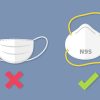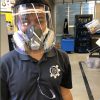The COVID-19 pandemic has exposed weaknesses throughout the healthcare supply chain. Single point-of-failure supplier relationships on critical supplies, JIT inventory levels, limited domestic manufacturing sites, etc. have revealed the vulnerability of our hospitals. Many healthcare facilities across the country are finding themselves quickly running out of even the most basic supplies.
The National Supply Survey published by the Association for Professionals in Infection Control and Epidemiology showed that N95 respirators, surgical masks and isolation gowns are in critically short supply (48% reported being completely or nearly out of inventory). The same survey showed that disinfectant wipes and solutions are also at critical levels. Hospitals and other healthcare facilities throughout the United States reported being completely out of disinfectant wipes, which are needed to ensure point of care devices are safely disinfected to protect both clinicians and patients.1
Device manufacturers commonly provide disinfection instructions that suggest using disinfectant wipes despite well-documented issues with this procedure. In various studies, disinfectant wipes have been shown to:
- Create a significant risk of users developing COPD2
- Be a source of contamination when improperly applied3,4
- Frequently damage/degrade medical devices due to chemically induced environmental stress cracking5
- Create long-term environmental issues6
- Be used incorrectly due to manual and inconsistent protocols (i.e., end users not observing adequate disinfectant contact time)7
The COVID-19 pandemic requires us to rethink our current device disinfection procedure, which has not changed significantly in the past 100 years—using a cloth to manually/uniformly spread disinfectant chemicals (or at least try to).
Two disinfection technologies have received increased focus in midst of the COVID-19 pandemic—various applications of hydrogen peroxide vapor and ultraviolet light systems. However, there are important differences to consider with these disinfection technologies, including regulatory oversight and technical limitations.
How Are These Technologies Regulated?
Hydrogen Peroxide
Hospital disinfectants, such as hydrogen peroxide, are regulated by the Environmental Protection Agency (EPA), not the FDA as many think. The FDA regulates high-level disinfectants and sterilants in the healthcare setting when used to treat devices that contact mucous membranes or enter sterile tissues.
In order to meet the criteria of an EPA-registered hospital disinfectant, a product and process must show efficacy against two organisms at minimum—Staphylococcus aureus and Pseudomonas aeruginosa. To make additional efficacy claims in treating other organisms, further testing must be completed for each organism (or an approved proxy organism) under good laboratory practice (GLP) protocols in a laboratory subject to EPA audit. If results are successful, they are then reviewed and approved by the EPA for product label claims.
Hydrogen peroxide vapor has been proven to be effective and is compatible with most surfaces (plastics, glass, silicone, even many metals). It is important to note that hydrogen peroxide is regulated by the FDA when used to achieve sterilization or high-level disinfection, and regulated by the EPA when used as a low- or intermediate-level disinfectant.
There have been multiple emergency use authorizations issued for the use of hydrogen peroxide vapor as a method to reprocess N-95 respirators during the COVID-19 supply crisis. In addition to the FDA, the Department of Defense, Duke University, the Battelle Corporation, Advanced Sterilization Products, Steris and the University of Massachusetts have all published studies that demonstrate hydrogen peroxide’s ability to disinfect PPE in this time of crisis.
UV Light Systems
UV light systems, on the other hand, do not require FDA approval or EPA registration. Users of these systems must rely solely on the manufacturers claims, which are not approved by any regulatory body. There are no established minimum efficacy criteria for these systems, and much of the research has been conducted through industry sponsorship. UV industry associations have endeavored to create the image of regulatory agency protocols, but no government approval or registration is provided.
In a recent CDC protocol, both hydrogen peroxide vapor and UV light systems were indicated for use in an emergency to reprocess respirators and other PPE. It is important to note that the CDC showed only a 3-log reduction for products treated with UV light, while hydrogen peroxide vapor resulted in a 5-log reduction. Additionally, per a recent NIH Study only two cycles of UV light were indicated as safe for use on respirators because more than two cycles left significant damage to the equipment’s elastics and fibers.8
Under the EPA Emerging Viral Pathogens Program, a product can apply for an emerging viral pathogen claim based on past EPA-approved claims for viruses that are more difficult to kill. SARS-CoV-2 is an enveloped virus, so a disinfectant product must show efficacy against both small non-enveloped viruses and large non-enveloped viruses which are inherently harder to kill. In this case, a UV system’s 3-log reduction result does not meet the EPA standard of efficacy for the disinfection of emerging viral pathogens.
Why Does Log Reduction Matter?
As discussed, not all products meet EPA guidelines as disinfectants. When evaluating products for disinfection, log reduction capability should be well understood. It is beneficial to take a close look at a pathogen that has been causing issues for healthcare facilities across the country–Clostridioides difficile. Clostridioides difficile (C. diff) is a spore bacterium that can be life threatening and is considered a healthcare associated infection (HAI). C. diff causes up to a half a million illnesses per year, resulting in about 15,000 annual deaths.9
Medical equipment that is exposed to C. diff must be thoroughly disinfected in order to limit the spread of infection. There are 3.8 million colony forming units (cfu) of C. diff in 1 gram of stool. On average, patients infected with C. diff have 200 grams per stool event, with events occurring 8–10 times a day.10
That’s up to 76 billion cfu (colony forming units) of C. diff released into the environment every day per patient.
This means the following:
- 1 log reduction = 7,600,000,000 untreated cfu
- 2 log reduction = 760,000,000 untreated cfu
- 3 log reduction = 76,000,000 untreated cfu
As noted in the CDC’s guidance, UV light systems may only achieve a 1- to 3-log reduction in organisms like C. diff and SARS-CoV-2, resulting in a significant amount of untreated colony forming units that have the capability to grow and infect patients as well as staff.
The Joint Commission has found a general inadequacy in the disinfection of medical devices at healthcare facilities. The fifth most-cited standard for 2018 was “02.02.01—The hospital reduces the risk of infections associated with medical equipment, devices, and supplies.” With an average 70.9% noncompliance percentage, the presence of C. diff, SARS-CoV-2 and other dangerous pathogens are a threat to patient and staff safety.
The Need for Reliable New Technologies in a Time of Crisis and Beyond
UV light systems are seemingly falling into a regulatory gap, where despite significant variability, many companies are making unregistered claims to demonstrate equivalency to EPA regulated hospital disinfectants.
Strong arguments can be made that other disinfection technologies, including products that use hydrogen peroxide in an automated system are much more reliable and consistent than either manual wipes or UV light. These products must be registered with the EPA or FDA and are subject to rigorous efficacy testing.
Difficult decisions will have to be made throughout this pandemic as there are reported critical shortages of disinfectant solutions, wipes and PPE. However, in order to make informed decisions, it is important to understand the regulatory requirements and the reliability of log reduction claims made by all disinfection technologies.
References
- Association for Professionals in Infection Control and Epidemiology. (March 27, 2020). “National Supply Survey”.
- Dumas, O., Varraso, R., Boggs, K., et al. “Association of Occupational Exposure to Disinfectants with Incidence of Chronic Obstructive Pulmonary Disease Among US Female Nurses”. JAMA Network Open 2(10), (2019), doi: 10.1001/jamanetworkopen, 2019.
- Ramm, L., Siani, H. and Wesgate R. (2015) “Pathogen transfer and high variability in pathogen removal by detergent wipes “. American Journal of Infection Control. 43(7). pp. 724-728.
- Sundheim, G., et al. (1998).“Bacterial resistance to disinfectants containing quaternary ammonium compounds.” International Biodeterioration & Biodegradation. 41(3-4). pp. 235-239, doi: 10.1016/S0964-8305(98)00027-4.
- Sastri, V. (2010). Plastics in Medical Devices: Properties, Requirements and Applications, William Andrew Applied Science Publishers, Plastics Design Library. pp. 33-54.
- Allen, V., (2016) “Wet wipes could take 100 years to break down: Products contain plastic that is ‘virtually indestructible.'” The Daily Mail.
- Song, X., Vossebein L. and Zille, A. (2019). “Efficacy of disinfectant-impregnated wipes used for surface disinfection in hospitals: a review.” Antimicrobial Resistance and Infection Control, 8(139). doi: 10.1186/s13756-019-0595.
- Fischer, et al. (2020). “Assessment of N95 respirator decontamination and re-use for SARS-CoV-2”. National Institute of Health.
- CDC. (November 2019). “Clostridioides difficile Infection”. CDC Website.
- Naaber, P., et al. (2011). “Quantification of Clostridium difficile in antibiotic-associated-diarrhea patients.” US National Library of Medicine. 49(10).
- Patient safety and Quality Healthcare. (2019). “Once Again, Safety Issues Top List of Most-Cited TJC Standards“.







